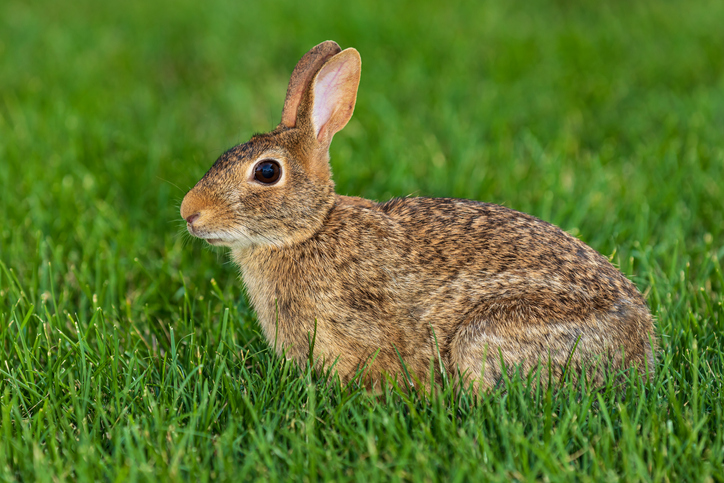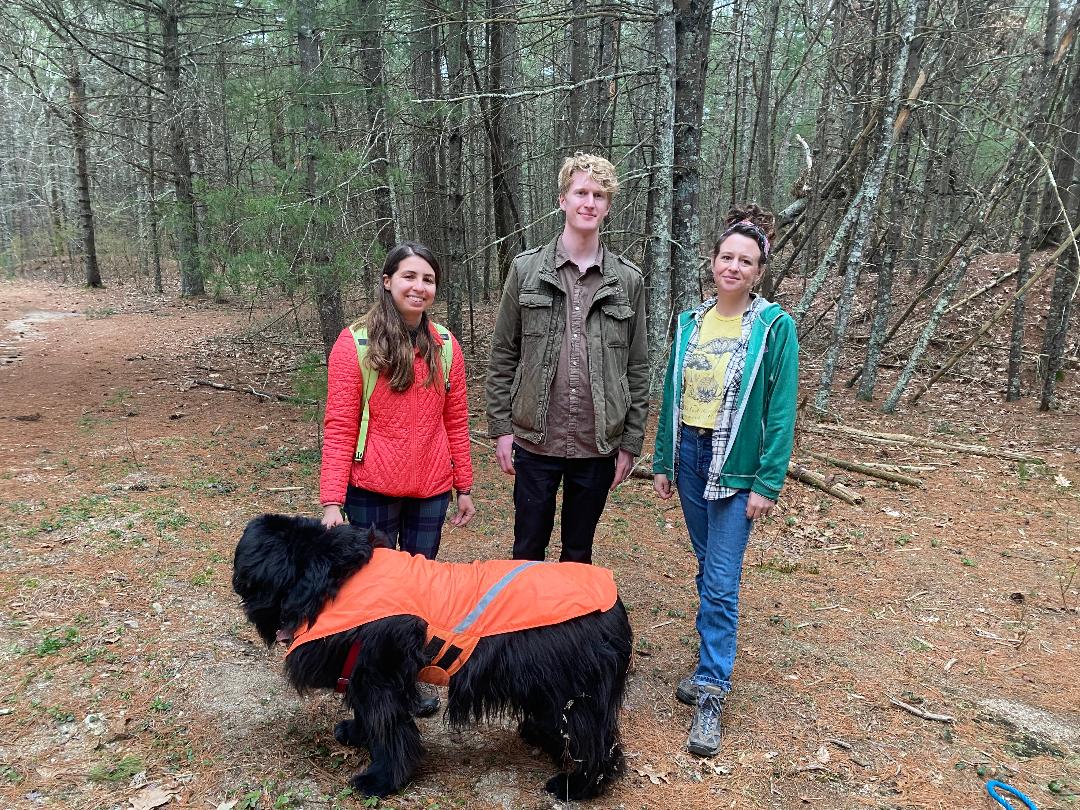Got Bunnies? Fencing, Native Plants Best Way to Deter Them
July 31, 2023
Does it seem as though every time you look out into the backyard, or drive through a suburban neighborhood, you see a rabbit or two?
You’re not alone. Anecdotal evidence seems to indicate that this is a banner year for bunnies.
There could be a few reasons for that, according to Mary Gannon, a principal biologist and wildlife outreach coordinator for the Rhode Island Department of Environmental Management.
Rabbit populations “can certainly boom … due to natural absence or fewer predators and a subsidized abundance of food,” she said. In the case of rabbits, that hop-through restaurant is probably your beloved flower or vegetable garden.
“They particularly love beans, peas, and lettuce, and will munch on annual flower seedlings,” Gannon said. “Clover is a big favorite as well.”
What they don’t like, Gannon said, is plants in the mint family, milkweed, onions, and garlic — although she has seen young milkweed and allium stems nibbled by curious rabbits. And they have even taken a bite out of her native eastern prickly pear cactus, she said, “which made me wonder if they dare each other to sample certain plants.”
The rabbits you are seeing in your yard are either eastern cottontails or New England cottontails. The eastern cottontail was introduced in the 1900s to revive the declining native New England cottontail population, according to DEM. During the past 50 years the range of this once-common rabbit has shrunk and its population has dwindled. Today, biologists believe there are only around 13,000 New England cottontails left, according to New England Cottontail.
Eastern and New England cottontails look alike, with slight differences in their coloring. Eastern cottontails often have a small white spot on their foreheads, while New England cottontails can have a small black spot on their foreheads. Both rabbits can have colorings ranging from red-brown to black to gray-brown, with white undersides. The Eastern cottontail is slightly bigger than the New England cottontail, with longer ears and bigger eyes.
Cottontails can live in open fields, forest edges, barrier beaches, the borders of marshy regions, and areas of thick cover. They also like areas near a water source, such as a creek, pond, or stream, according to DEM. Backyard rabbits are most likely eastern cottontails, because New England cottontails favor open woods and shrub thickets, according to DEM.
Rabbits are, as the saying goes, prolific breeders. Females have two to three litters a year and can mate right after giving birth. The average litter is five babies, and the gestation period is about 28-30 days.
The babies are born hairless, blind, and deaf. They are weaned at about three weeks of age and leave the nest, but many do not survive, succumbing to predators or disease. A rabbit is considered full-grown at four months of age.

If you think you have rabbits nibbling at your garden, check the bite marks. Rabbits’ front top teeth are uprooted and grow continuously throughout their lives. Their incisors allow them to gnaw on tree bark as well as clip shoots and buds. They leave behind a knife-like, slanting cut on the things they eat, but they do not leave any teeth marks behind. This bite style is unlike that of deer, who lack upper teeth and must grab and pull the vegetation they eat, leaving jagged ends.
The most effective way to keep from seeing these nibble-marks in your garden is to put up a fence.
“The best success I’ve had is by installing secure fencing with small holes (1×1 inches) around my entire vegetable garden, making sure that there aren’t gaps at the base for smaller rabbits to slip through,” Gannon said. “For newer perennial flowers or small shrubs, I encircle them in 2-foot-high chicken wire cages and use landscape staples to tack them down so that they don’t topple in the wind or get pushed over by a determined bunny. Once the perennials get big enough, I remove the cages, and try to keep them around smaller shrubs until they get bigger. Rabbits will nibble on bark in the winter, so protecting young trees and shrubs this way has helped.”
Gannon said she has also had success sprinkling cayenne pepper around her plants. “While inexpensive and easy, it’s kind of a pain, particularly in very rainy years like we’ve had this year because you have to go out and reapply,” she said.
Gannon said ornamental plants are more at risk of being eaten by a rabbit than native plants, some of which are deer and rabbit resistant.
She said she has noticed that rabbits have been less interested in her plants now that her lawn isn’t “a perfect carpet. We decided not to run the sprinklers, fertilize, or put down weedkiller, so now it’s a patchwork of different weeds, with lots of clover, dandelions, and violets. The rabbits love it,” she said. “In a lawn monoculture, rabbits [and other critters] might see the standalone ornamental flowers as a delicious oasis. I’m thinking of my small patch of tulips, may they rest in peace.”
If you feel as though your yard is overrun with rabbits this year, take heart. It could be worse. You could be living in Wilton Manors, Fla., a Fort Lauderdale suburb that is being overrun with cute little lionhead rabbits. Two years after a resident turned their domesticated bunnies loose rather than taking them with them when they moved, there’s more than 100 lionheads living in the neighborhood. Local animal rescue organizations are getting involved to rehome the bunnies.




I’m glad Gannon learned that a perfect lawn treated with weed killers and pesticides was part of the bunny problem. Finally
It would be spectacular to see some of these urban rabbits relocated to the state management areas where less would be hit by cars. Granted hunting is allowed but the meat wouldn’t be going to waste. I never see rabbits on stateland any longer but around Warwick see 6-7-8 in every other yard.
I am glad the reporter used the phrase, “according to DEM,” after each statement made about the New England Cottontail. That is because these statements from DEM are full of factual inaccuracies. DEM has no clue about the natural history of the state. Not since they got rid of the Rhode Island Natural Heritage Program in 2007.
New England Cottontail were not widespread in Rhode Island 400 years ago before European settlement in Rhode Island. Only 1%-4.5% of the landscape was early-successional habitat while up to 90% was Old Growth Forest. When the Primary Old Growth Forest was clearcut for agriculture which was later abandoned from the mid 1800s to the early 1900s, it created a lot of early successional habitat which caused the New England Cottontail populations to unnaturally rise. Since the mid 1900s, our forests have started to mature meaning there is less early-successional habitat which has caused the population of New England Cottontail to go down. This is not a bad thing; it is just the New England Cottontail returning to their natural population levels before European settlers altered the landscape in the 1600s and 1700s.
However, environmental organizations including DEM continue to log mature forests for early successional habitat to try to stop this natural population decline of the New England Cottontail at the expense of native species such as the endangered Cerulean Warbler and Wood Thrush which were widespread in Rhode Island 400 years ago that need mature forest habitats and are currently threatened because of the logging of mature forests in Rhode Island under the guise of forest management.
The real reason though why DEM sustains the New England Cottontail is not ecological in nature, but because the New England Cottontail is a gaming species that hunters go for. It’s interesting that DEM claims to be concerned about the declining population of the New England Cottontail but still allows for the species to be hunted in the state.
Cerulean Warbler and Wood Thrush are not gaming species which is why DEM could care less about them and the destruction of their habitats.
Here is a scientific paper published this year about the facts regarding the New England Cottontail as well as early-successional habitats and the natural history of the northeast. One of the authors of the paper is Dr. David Foster of Harvard University. Despite this, DEM has no interest in this groundbreaking paper which I have tried to share with them. DEM doesn’t like to look at any science that doesn’t justify their pro-logging and pro-hunting priorities.
https://www.frontiersin.org/articles/10.3389/ffgc.2022.1073677/full#main-content
If the author of this article would like to include my statements in the above article so DEM’s false narrative is not the only information people are getting, they are free to do so.
Nathan Cornell
President of the Old Growth Tree Society